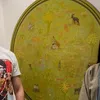“A crisis is a test for creativity and persistence” – how these MayinArt artists stayed engaged during the pandemic
Three artists share how the pandemic compelled them to push their creativity, cope with shortages, and give back to society. Here are their inspiring artworks and insights.
Launched in 2014, PhotoSparks is a weekly feature from YourStory, with photographs that celebrate the spirit of creativity and innovation. In the earlier 540 posts, we featured an art festival, cartoon gallery. world music festival, telecom expo, millets fair, climate change expo, wildlife conference, startup festival, Diwali rangoli, and jazz festival.
Founded by Krish Datta and Avik Bandyopadhyay, Singapore-based MayinArt is a digital platform to showcase Indian and Southeast Asian art. Images of some of these artworks have been reprinted in this article series with permission from MayinArt.
See our extended coverage here, with pictorial highlights and artist insights. The artworks are priced from a few hundred dollars up to around $3,000.
“More than half of our works are sold outside Singapore, across Australia, Europe, USA and India,” Avik Bandyopadhyay explains, in a chat with YourStory.
“We do have a competitive element with hundreds of physical galleries of which over 50 are in Singapore itself. However, we have the advantage of the reach and a much lower price point given the quality of work we offer,” he adds.

Animal Story by Riki Antoni
Riki Antoni
“Art can be interpreted as a form of gratitude. It is with art I can understand myself,” says Indonesian surrealistic pop artist Riki Antoni. He sees success in the audience and public appreciation also, which can lead to sales as an effect.
“I do not make artworks with a certain style because it may limit creativity. The closeness of an object creates an emotion, this is how the artwork will develop over time,” he explains.
His cartoonish palette illustrates how children see the wonder and playfulness of the world around them. The themes sharply contrast with the realities like poverty and war.
Though the COVID-19 pandemic has affected gallery exhibitions and sales, he continues to work as usual. “Always keep working, whatever the conditions – because in a crisis, artists are tested for creativity and persistence,” Riki advises aspiring artists.

Wind Song 2 (L), Trilokini 10 (R) by Romi
Romicon Revola
“Art is a vehicle in which I explore life and the human experience. Art is also the pathway to a higher realm of consciousness,” explains Bengaluru-based contemporary artist Romicon ‘Romi’ Revola. Her works include sculpture, installation, paintings, and video.
“I believe that art opens up a sacred portal where we are connected to physical, mental and spiritual realms all at once,” she adds.
She also cherishes the journey of discovery that her work leads her on. “It’s a beautiful journey where I get to pick up any subject that interests me – from cosmology to psychology to ecology – and really immerse myself in it and explore various aspects of it. It’s a very enriching experience that I cannot describe in words,” Romi enthuses.
She sees success in having enough opportunities to explore her full potential as an artist. “There’s no limit to an artist’s growth and imagination. As a sculptor and installation artist I need a lot more resources than other forms of visual art to bring my ideas to life,” she adds.
“So, if there is a constant flow of patrons and collectors buying my work, I can continue to create and evolve, to explore and expand the boundaries of my art practice,” Romi says.

Trilokini 7 by Romicon Revola
She describes her creative process as a mix of research and drawing from direct lived experiences. “I give shape and form to the concept, choosing which materials I will work with and the way each piece will manifest,” she says.
She worked on large sculptures and site-specific installations for about eight years. “My focus then shifted to other mediums and subjects. I started making work in response to what was happening around me,” Romi recalls.
“There were major ecological challenges caused by unplanned urbanisation in Bengaluru. We had lakes catching fire, water shortage, landfill management issues – and every day was a battle against various forms of pollution,” she laments.
She became interested in juxtaposing man-made materials, especially plastic, with fragile, natural, bio-degradable materials. “I enjoyed making these ephemeral objects. I worked with tree trunks, turmeric, cotton and natural fibre, which would all disintegrate one day,” Romi describes.
In 2018, she went back to working in metal and other permanent materials, but with a shift in visual language in her Cosmic Bloom series. “My visual language has evolved through continuous exploration of ideas along with materials and technologies. I’m a curious person by nature and this curiosity to understand and express the gamut of human experience is what drives me to create art,” Romi affirms.
Though being an independent artist requires becoming used to ups and downs in life, the pandemic lockdown was tough and a number of her projects and exhibitions were postponed or cancelled. “The first couple of months were stagnant but then slowly a few opportunities opened up,” she recalls.
“Art enthusiasts also started buying more art online during the lockdown. Many collectors started renovating their homes as everyone started working from home and wanted to fill them with art to enrich their ambience. So I became busy again,” Romi says with relief.
“I do realise that hundreds of emerging and younger artists are badly affected,” she adds. She volunteered with an art NGO to create virtual shows and help generate some revenue.
“I’ve always seen myself as not only an artist but also an entrepreneur. Evolving sustainable revenue models to help artists keep their art practices alive is something that interests me. I hope to contribute to that narrative in my own small way,” Romi says.

Biosphere 13 by Romicon Revola
She also offers tips for aspiring artists. “Constant growth and evolution are the keys. Your journey of self-growth and self-discovery is what translates into your artistic work. So stay curious and challenge yourselves constantly,” Romi advises.
“There is a lot of learning that happens after you leave the comfort of your art school and step into the real world,” she explains. Artists need to figure out how to balance artistic pursuits with practical realities like generating revenue for sustainability.
“This phase is often challenging. But if you are resilient, you will find your footing in the art world. Be prepared to be tested on every level and don’t expect instant results,” Romi cautions.
Sriyadi Srinthil
“Art can be a reflection of life since the artist's personal experience is reflected in the work. Or art can be a monument to an event in life,” explains Sriyadi Srinthil, a contemporary realism artist from Indonesia.
Some of the narrative in his artworks is around the simplicity of rural life. His artworks also convey social criticism. Sriyadi has a graduate degree in philosophy and is a self-taught artist.
“For example, the pandemic time is interpreted differently by each artist, as a significant event of our era,” he explains.
“Success for artists is when they effectively express ideas and experiences of life through artwork, and when that message can be understood by art connoisseurs and the general public,” Sriyadi describes.

The dancer by Sriyadi Srinthil
The pandemic has been tough for the art world. “Receiving commissioned works during the pandemic was one way to support the family’s needs and continue making art. Several artworks on the theme of the pandemic were made, although things were a bit slow,” he explains.
He also offers tips for aspiring artists. “Keep on making art even in difficult circumstances, even from the simplest materials. It can become a good work of art as long as it is done wholeheartedly. To keep the spirit of working, spend more time with other fellow artists,” Sriyadi signs off.
Now, what have you done today to pause in your busy schedule and find new avenues to harness your creative core?

Within my self by Rudragaud L Indi

Avisar by Supriya Polley

beauty no 1 by Suryadi Suyamtina

carry the stone(new machine series) by Nugroho Heri Cahyono

city into cat by Shrea Ghosh

Dream City 2 by Subir Dey

forest #1 by Refijon

friendship by Riki Antoni

journey (imaginarium) by Triana P

Mask of Goddess 26 by Prakash G Nayak

Unlock by Rudragaud L Indi

Woman #2 by Sriyadi Srinthil

My Garden by Sandhya Wadhwani

She by Sujata Sah Sejekan
See also the YourStory pocketbook ‘Proverbs and Quotes for Entrepreneurs: A World of Inspiration for Startups,’ accessible as apps for Apple and Android devices.
Edited by Suman Singh









